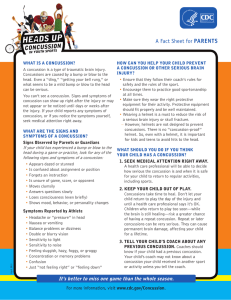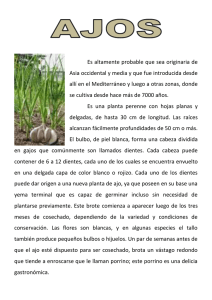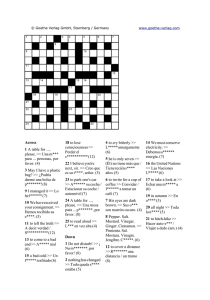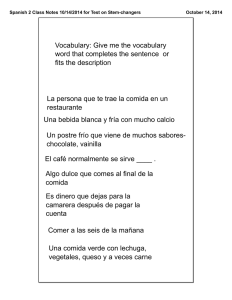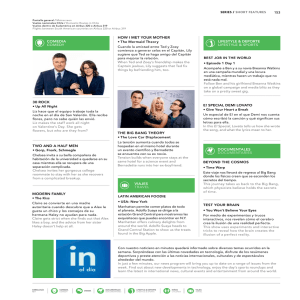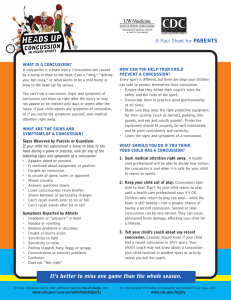Sign up by September 9th.
Anuncio
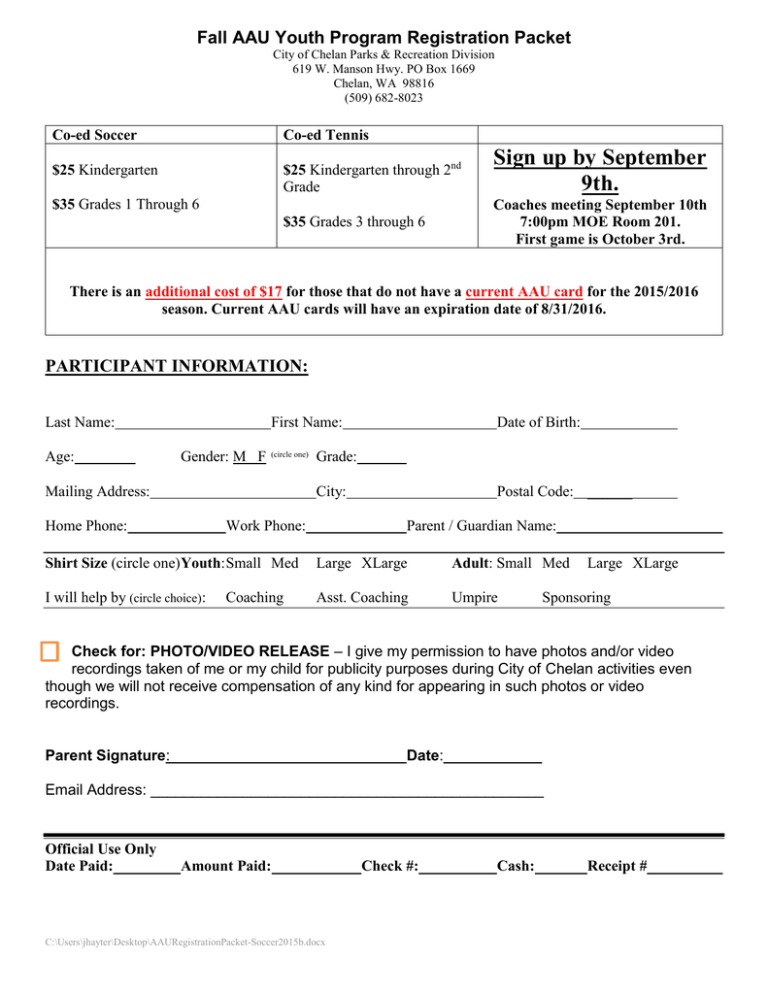
Fall AAU Youth Program Registration Packet City of Chelan Parks & Recreation Division 619 W. Manson Hwy. PO Box 1669 Chelan, WA 98816 (509) 682-8023 Co-ed Soccer Co-ed Tennis $25 Kindergarten $25 Kindergarten through 2nd Grade Sign up by September 9th. $35 Grades 3 through 6 Coaches meeting September 10th 7:00pm MOE Room 201. First game is October 3rd. $35 Grades 1 Through 6 There is an additional cost of $17 for those that do not have a current AAU card for the 2015/2016 season. Current AAU cards will have an expiration date of 8/31/2016. PARTICIPANT INFORMATION: Last Name: Age: First Name: Gender: M F (circle one) Mailing Address: Date of Birth: Grade: City: Home Phone: Work Phone: Postal Code: ______ Parent / Guardian Name: Shirt Size (circle one) Youth: Small Med Large XLarge Adult: Small Med I will help by (circle choice): Asst. Coaching Umpire Coaching Large XLarge Sponsoring Check for: PHOTO/VIDEO RELEASE – I give my permission to have photos and/or video recordings taken of me or my child for publicity purposes during City of Chelan activities even though we will not receive compensation of any kind for appearing in such photos or video recordings. Parent Signature: Date: Email Address: _______________________________________________ Official Use Only Date Paid: Amount Paid: C:\Users\jhayter\Desktop\AAURegistrationPacket-Soccer2015b.docx Check #: Cash: Receipt # Minor Waiver/Release RELEASE OF LIABILITY FOR MINOR PARTICIPANTS READ BEFORE SIGNING IN CONSIDERATION OF ________________________________________, my child/ward, being allowed to participate in Name of Minor Child/Ward any way in the City of Chelan Parks & Recreation Department related events and activities, the undersigned acknowledges, appreciates, and agrees that: The risk of injury to my child from the activities involved in these programs is significant, including the potential for permanent disability and death, and while particular rules, equipment, and personal discipline may reduce this risk, the risk of serious injury does exist; and, 1. FOR MYSELF, SPOUSE, AND CHILD, I KNOWINGLY AND FREELY ASSUME ALL SUCH RISKS, both known and unknown, EVEN IF ARISING FROM THE NEGLIGENCE OF THE RELEASES or others, and assume full responsibility for my child’s participation; and, 2. I willingly agree to comply with the program’s stated and customary terms and conditions for participation. If I observe any unusual significant concern in my child’s readiness for participation and/or in the program itself, I will remove my child from the participation and bring such attention of the nearest official immediately; and, 3. I myself, my spouse, my child, and on behalf of my/our heirs, assigns, personal representatives and next of kin, HEREBY RELEASE AND HOLD HARMLESS the City of Chelan Parks & Recreation Department; its directors, officers, officials, agents, employees, volunteers, other participants, sponsoring agencies, sponsors, advertisers, and if applicable, owners and lessor of premises used to conduct the event (“Releasees”), WITH RESPECT TO ANY AND ALL INJURY, DISABILITY, DEATH, or loss or damage to person or property incident to my child’s involvement or participation in these programs, WHETHER ARISING FROM THE NEGLIGENCE OF THE RELEASEES OR OTHERWISE, to the fullest extent permitted by law. 4. I, for myself, my spouse, my child, and on behalf of my/our heirs, assigns, personal representatives and next of kin, HEREBY INDEMNIFY AND HOLD HARMLESS all the above Releasees from any and all liabilities incident to my involvement or participation in these programs, EVEN IF ARISING FROM THEIR NEGLIGENCE, to the fullest extent permitted by law. I HAVE READ THIS RELEASE OF LIABILITY AND ASSUMPTION OF RISK AGREEMENT, FULLY UNDERSTAND ITS TERMS, UNDERSTAND THAT I HAVE GIVEN UP SUBSTATIAL RIGHTS BY SIGNING IT, AND SIGN IT FREELY AND VOLUNTARILY WITHOUT ANY INDUCEMENT. ____________________________________________ (PARENT/GUARDIAN SIGNATURE) ______________________________________ (PRINT NAME) Date Signed:__________________________________ UNDERSTANDING OR RISK I understand the seriousness of the risks involved in participating in this program, my personal responsibilities for adhering to rules and regulation, and accept them as a participant. ____________________________________________ (PARTICIPANT SIGNATURE) Date Signed: _________________________________ C:\Users\jhayter\Desktop\AAURegistrationPacket-Soccer2015b.docx ______________________________________ (PRINT NAME) Medical Release Form __________________________________has permission to participate in the City of Chelan Parks and (Name of Minor Child/Ward) Recreation AAU Program. I the undersigned, parent/guardian, assume all risks and hazards incidental to participating in this activity and do hereby authorize the identified representative of the AAU program to obtain such medical diagnostic services as may be deemed necessary. Emergency treatment of a life threatening condition is authorized. Telephone contact for management of all serious conditions will be attempted if possible. INFORMATION ABOUT YOUR CHILD: ANY MEDICAL PROBLEMS: CIRCLE YES OR NO If yes, please explain:_____________________________________________________ ______________________________________________________________________ ALLERGIC TO ANY DRUGS: CIRCLE YES OR NO If YES, please list the drugs:__________________________________________________ Parent/Guardian Name: ______________________________Phone__________________ Child’s Name_________________________________ Insurance Company: _________________________________Number________________ Doctor: ___________________________________________Phone _________________ Parent/Guardian Signature: ____________________________Date __________________ Coaches will keep this document with them at all games and practices. C:\Users\jhayter\Desktop\AAURegistrationPacket-Soccer2015b.docx City of Chelan Parks & Recreation AAU Youth Programs Parent and Player Contract Guidelines 1. No player will be allowed to practice or play in a game unless this form is returned. 2. During the season, all players will get to play in at least half the games if they: A. Attend practices regularly and be on time. Arrive 15 minutes or earlier to games. B. Work to the best of your ability and listen to your coaches. C. Treat all coaches, teammates, opponents, and officials with respect. 3. During the season ALL PARENTS WILL: A. Express any concerns you have directly to your child’s coach. B. Make arrangements for transportation to and from practices and games. C. Call the coach when your child is unable to attend a practice or game. D. Inform the Youth Sports Coordinator, Mike Haerling at 670-0180, of any remaining issues or complaints, after talking to the coach first. E. Show good sportsmanship and positive support to your child and others. 4. A Sports Board will be set up at the beginning of the season to hear any complaints that are not settled by the Youth Sports Coordinator. Goals Our goal is to provide an opportunity to play organized sports for all kids that want to play with an addition to the following: 1. Provide equipment, facilities, coaches, practice and game schedules. 2. Teach the fundamental skills of a sport with the understanding of play. 3. Develop good work ethics and positive attitudes 4. Learn to make commitments and be responsible 5. Learn teamwork and how to get along with others in group situations. 6. Develop and display good sportsmanship. 7. Make friends and have fun. Please support this program and not undermine it if things don’t go the way you want them to. Remember, all coaches are volunteers and are doing the best they can. Please acknowledge that you and your child have read this document by signing your names below, and with the understanding that you can both be removed from the facility for not being respectful to others or following the sportsmanship guidelines at all times. Player signature _____________________________________ Date ______________ Parent signature _____________________________________ Date ______________ C:\Users\jhayter\Desktop\AAURegistrationPacket-Soccer2015b.docx HEADS UP: CONCUSSION IN YOUTH SPORTS A Fact Sheet for AAU Member Parents and AAU Member Athletes (Requirement to Read and Signed by parents and athletes) Return this form to AAU member team coach. WHAT IS A CONCUSSION? A concussion is a brain injury that is caused by a bump or blow to the head. It can change the way your brain normally works. It can occur during practices or games in any sport. Even a “ding,” “getting your bell rung,” or what seems to be a mild bump or blow to the head can be serious. A concussion can happen even if you haven't been knocked out. You can’t see a concussion. Signs and symptoms of a concussion can show up right after the injury or may not appear or be noticed until days or weeks after the injury. If your child reports any symptoms of concussion, or if you notice the symptoms yourself, seek medical attention right away. PARENTS AND GUARDIANS What are the signs and symptoms of a concussion observed by Parents/Guardians: If your child has experienced a bump or blow to the head during a game or practice, look for any of the following signs and symptoms of a concussion: Appears dazed or stunned Is confused about assignment or position Forgets an instruction Is unsure of game, score, or opponent Moves clumsily Answers questions slowly Loses consciousness (even briefly) Shows behavior or personality changes Can’t recall events prior to being hit or falling Can’t recall events after being hit or falling How can a Parent/Guardian help their child prevent a concussion? Every sport is different, but there are steps your children can take to protect themselves from concussion. Ensure that they follow their coach’s rules for safety and the rules of the sport. Encourage them to practice good sportsmanship at all times. Make sure they wear the right protective equipment for their activity (such as helmets, padding, shin guards, and eye and mouth guards). Protective equipment should fit properly, be well maintained, and be worn consistently and correctly. Learn the signs and symptoms of a concussion. What should a Parent/Guardian do if they think their child has a concussion? 1. Seek medical attention right away. A health care professional will be able to decide how serious the concussion is and when it is safe for your child to return to sports. Notify your child's coach if you think your child has a concussion. 2. Keep your child out of play. Concussions take time to heal. Don’t let your child return to play until a health care professional says it’s OK. Children who return to play too soon—while the brain is still healing—risk a greater chance of having a second concussion. Second or later concussions can be very serious. They can cause permanent brain damage, affecting your child for a lifetime. 3. Tell your child’s coach about any recent concussion in ANY sport or activity. Your child’s coach may not know about a concussion your child received in another sport or activity unless you tell the coach. ATHLETES What are the symptoms of a concussion? Headache or “pressure” in head Nausea or vomiting Balance problems or dizziness Double or blurry vision Bothered by light Bothered by noise Feeling sluggish, hazy, foggy, or groggy Difficulty paying attention Memory problems Confusion Does not “feel right” What should an athlete do if they think they have a concussion? Tell your coaches and your parents. Never ignore a bump or blow to the head even if you feel fine. Also, tell your coach if one of your teammates might have a concussion. Get a medical check up. A doctor or health care professional can tell you if you have a concussion and when you are OK to return to play. Give yourself time to get better. If you have had a concussion, your brain needs time to heal. While your brain is still healing, you are much more likely to have a second concussion. Second or later concussions can cause damage to your brain. It is important to rest until you get approval from a doctor or health care professional to return to play. It is better to miss one game than the whole season. How can athletes prevent a concussion? Every sport is different, but there are steps you can take to protect yourself. Follow your coach’s rules for safety and the rules of the sport. Practice good sportsmanship at all times. Use the proper sports equipment, including personal protective equipment (such as helmets, padding, shin guards, and eye and mouth guards). In order for equipment to protect you, it must be: o The right equipment for the game, position, or activity o Worn correctly and fit well o Used every time you play o Repaired and maintained Student Signature: Date: Parent/Guardian Signature: Date: IT’ S BETTER TO MISS ONE GAME THAN THE WHOLE SEASON. For more detailed information on concussion and traumatic brain injury, visit: http://www.cdc.gov/injury or www.cdc.gov/ConcussionInYouthSports CONMOCIÓN CEREBRAL EN DEPORTES JUVENILES Hoja de información para PADRES y DEPORTISTAS (Requirement to Read and Signed by parents and Athletes) Return this form to Team Coach. ¿QUÉ ES UNA CONMOCIÓN CEREBRAL? Una conmoción es una lesión al cerebro causada por un golpe en la cabeza. Puede cambiar la manera en que el cerebro trabaja normalmente. Puede ocurrir durante prácticas o partidos en cualquier deporte. Hasta un “golpecito insignificante,” o lo que pareciera ser un golpe leve en la cabeza puede ser muy serio. Una conmoción puede suceder aun si uno no ha recibido un golpe. Una conmoción no se puede ver. Los signos y síntomas de una conmoción pueden aparecer inmediatamente después de la lesión pero a veces no se nota sino que hasta días o semanas después de la lesión. Si su niño reporta algún síntoma de una conmoción o si usted nota los síntomas, busque atención médica inmediatamente. PADRES Y TUTORES LEGALES ¿Cuáles son los signos o síntomas de una conmoción cerebral que pueden observar los padres? Si su hijo ha sufrido un golpe en la cabeza durante una práctica o un partido, fíjese los siguientes signos o síntomas de una conmoción: Parece aturdido o sin sentido Está confuso con su tarea o posición Olvida una instrucción Está inseguro en el juego, anotación o con el oponente Se mueve torpemente Contesta las preguntas despacio Pierde el conocimiento (aunque sea brevemente) Muestra cambios de conducta o personalidad No recuerda eventos antes de haber recibido el golpe o al caer No puede recordar eventos después de haber recibido el golpe o de haberse caído ¿Qué pueden hacer los padres/tutores legales para ayudar a su hijo a prevenir una conmoción cerebral? Cada deporte es diferente pero hay pasos que sus niños pueden tomar para protegerse de una conmoción. Asegurarse de seguir las instrucciones de seguridad del entrenador y las reglas del deporte. Animarlos a que practiquen el buen espíritu deportivo todo el tiempo. Asegurarse de que usen el equipo de protección adecuado para la actividad (como cascos, almohadillas protección en los ojos, piel, ojos y boca). El equipo de protección debe quedar perfectamente, debe mantenerse en buenas condiciones y usarse con consistencia y correctamente. Aprender cuales son los signos y síntomas de una conmoción. ¿Qué debe hacer un padre/tutor legal si piensa que su hijo tiene una conmoción cerebral? 1. Buscar ayuda médica inmediatamente. Un profesional médico podrá decidir lo serio de la conmoción y el tiempo en que su hijo puede regresar a los deportes. Avísele al entrenador si piensa que su hijo tiene una conmoción. 2. Las conmociones toman mucho tiempo en sanar. No deje que su hijo regrese a jugar hasta que el doctor diga que está listo para regresar. Los niños que regresan a jugar muy pronto—mientras el cerebro está sanando—tienen un mayor riesgo de tener otra conmoción. Una segunda conmoción puede ser muy seria. Puede causar daño permanente al cerebro. 3. Avísele al entrenador sobre una reciente conmoción que haya sufrido en algún deporte o actividad. Pueda que el entrenador de su hijo no esté enterado que su hijo tuvo una conmoción a menos que usted se lo diga. DEPORTISTAS ¿Cuáles son los síntomas de una conmoción cerebral? Dolor o “presión” en la cabeza Nausea y vómito Problemas en el equilibrio o sensación de mareo Visión doble o borrosa Le molesta la luz Le molesta el ruido Se siente lento, confuso, olvidadizo o aturdido Dificultad para poner atención Problemas de memoria Confusión No se siente bien ¿Qué debe hacer un deportista si piensa que tiene una conmoción cerebral? Decirle a sus padres y a su entrenador. Nunca ignorar un golpe en la cabeza aun si te sientes bien. También decirle al entrenador si uno de tus compañeros tiene una conmoción. Hacerse un examen médico. Un doctor puede decir si tienes una conmoción y cuando debes regresar a jugar. Tomar tiempo para sanar. Si has tenido una conmoción, tu cerebro necesita tiempo para sanar. Mientras tu cerebro está sanando, puedes fácilmente tener otra conmoción. La segunda y otras conmociones pueden causar daño a tu cerebro. Es importante descansar hasta que el doctor te dé de alta. Es mejor faltar a un partido que a toda la temporada. ¿Cómo pueden los deportistas prevenir una conmoción cerebral? Cada deporte es diferente, pero hay pasos que puedes tomar para protegerte. Sigue las reglas de seguridad de tu entrenador y las reglas del deporte. Practica el buen espíritu deportivo todo el tiempo. Usa el equipo personal deportivo apropiado (como cascos, almohadillas, protección en la barbilla, ojos y boca). Para que el equipo te proteja este debe: o Ser el equipo correcto para el juego, posición o actividad o Usarse correctamente y que quede bien o Usarlo cada vez que juegues o Mantenerse en buenas condiciones Firma del estudiante: Fecha: Firma del padre/tutor legal: Fecha: ES MEJOR PERDER UN PARTIDO QUE PERDER TODA LA TEMPORADA Para más información sobre conmociones cerebrales o lesiones cerebrales traumáticas, visite: http://www.cdc.gov/injury or www.cdc.gov/ConcussionInYouthSports

